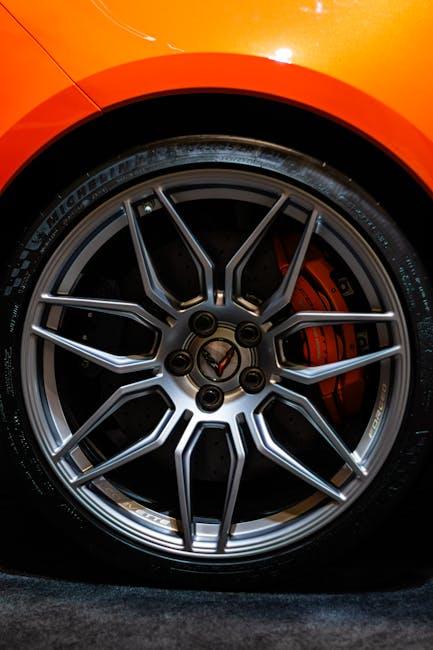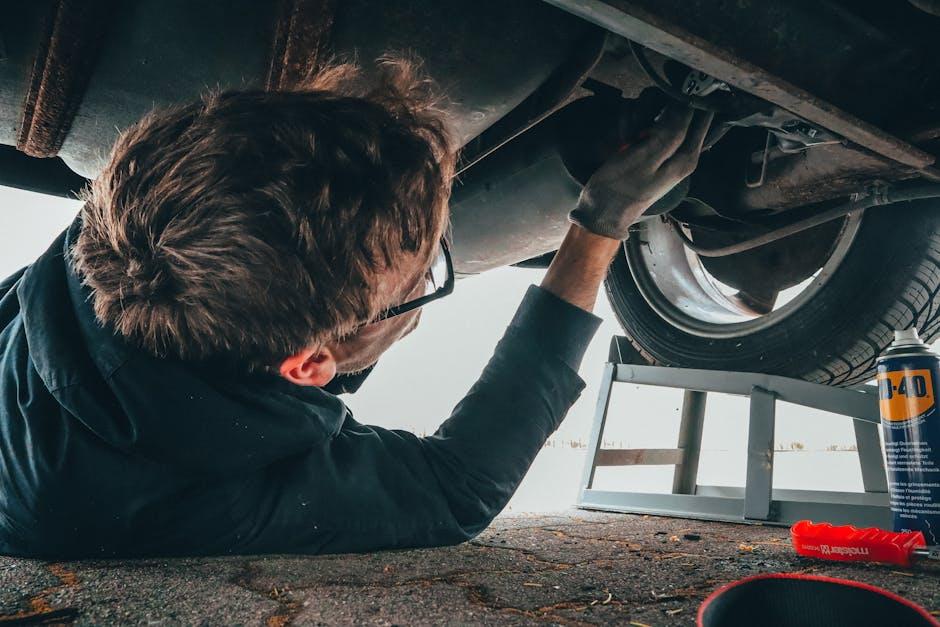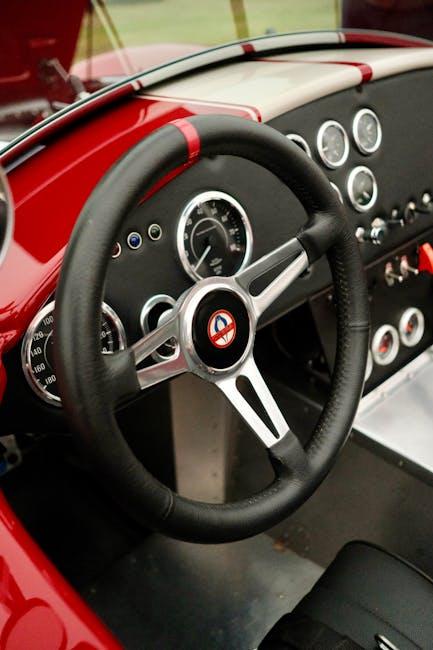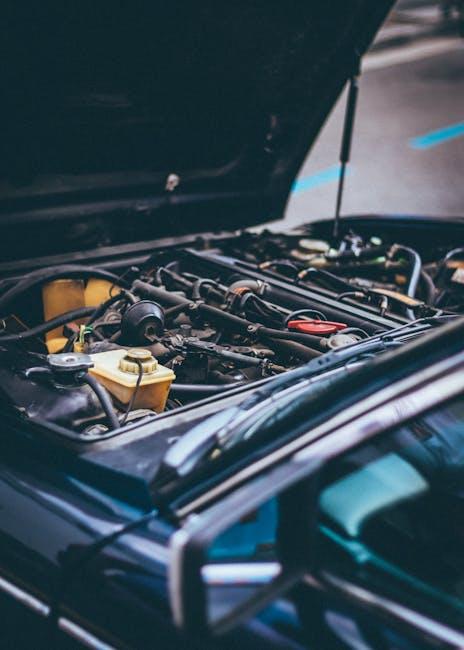Your car is more than just a means of transportation; it’s a trusted companion on countless journeys. But like any trusty companion, it occasionally sends subtle signals when something isn’t quite right under the hood. Recognizing these signs early can save you from unexpected breakdowns and costly repairs down the road. In this article, we’ll explore the common indicators that your car might be calling out for some expert attention—helping you stay safe, informed, and in control every time you hit the road.
Table of Contents
- Understanding Unusual Engine Noises and What They Mean
- Recognizing Warning Lights and When to Act Fast
- Identifying Changes in Brake Performance and Safety Tips
- Spotting Fluid Leaks Under Your Vehicle
- Detecting Tire Wear Patterns for Early Repairs
- Knowing When Dashboard Smells Signal Trouble
- Q&A
- To Conclude

Understanding Unusual Engine Noises and What They Mean
When your vehicle begins to emit unfamiliar sounds, it’s a vital sign that something under the hood requires attention. These noises often act as early warnings, hinting at potential issues before they escalate into costly repairs. For instance, a rhythmic knocking sound during acceleration could indicate worn piston rings or engine bearings, while a sharp ticking noise might suggest problems with the valves or lifters. Recognizing these auditory signals allows you to address problems quickly, ensuring your car’s performance remains smooth and reliable.
Engine sounds can be differentiated by their characteristics, making it easier to pinpoint the problem:
- Squealing: Could relate to loose or worn belts.
- Rattling: Often signals loose components or exhaust issues.
- Grinding: May reveal issues with the bearings or gears.
| Noise Type | Common Causes | Urgency Level |
|---|---|---|
| Knocking | Worn engine bearings, Piston issues | High |
| Squealing | Loose belt, Worn pulleys | Medium |
| Grinding | Damaged gears or bearings | High |

Recognizing Warning Lights and When to Act Fast
Every driver should be well-versed in the language of their dashboard. These illuminated symbols aren’t just random icons; they are your vehicle’s way of communicating urgent needs or subtle hints for maintenance. Common warning lights like the check engine, oil pressure, or battery alert are not to be ignored. When these lights flash or remain steadily lit, they signal that something beneath the hood requires immediate attention to prevent costly damage or breakdowns.
Knowing when to react swiftly can save you from hazardous situations and expensive repairs. If you notice any of the following, it’s time to act fast:
- Red warning lights: Indicate serious issues such as overheating or brake system errors.
- Flashing lights: Often represent urgent problems, especially with the engine or transmission.
- Any unexpected warning: Even if the vehicle seems to run fine, it’s better to get a professional check.
| Warning Light | What It Means | Recommended Action |
|---|---|---|
| Check Engine | Engine or emissions issue | Schedule diagnostic ASAP |
| Oil Pressure | Low oil pressure detected | Stop engine, check oil level |
| Battery Alert | Charging system problem | Test battery and alternator |
| Brake Warning | Brake system malfunction | Check brake fluid & system |

Identifying Changes in Brake Performance and Safety Tips
Brake systems are vital for your safety, so recognizing when their performance slips is crucial. Be alert to unusual noises like squealing or grinding, a soft or spongy brake pedal, or the car pulling to one side during braking. These subtle cues might signal worn brake pads, fluid leaks, or malfunctioning calipers. Ignoring these signs not only compromises your control but can lead to costly repairs or dangerous situations.
To maintain a secure driving experience, implement these safety tips:
- Regularly check brake fluid levels and top up as needed to ensure hydraulic integrity.
- Schedule brake inspections every 12,000 miles or at least once a year.
- Replace brake pads promptly at the first sign of thinning to avoid damage to rotors.
- Test your brakes after heavy rain or snow to confirm they are still responsive.
| Symptom | Possible Cause | Recommended Action |
|---|---|---|
| Squealing noise | Worn brake pads | Replace pads immediately |
| Soft brake pedal | Air in brake lines | Bleed brake system |
| Car pulling when braking | Uneven pad wear | Check alignment and brakes |

Spotting Fluid Leaks Under Your Vehicle
Discovering unexpected puddles beneath your vehicle can be alarming, but spotting such fluid leaks early can save you from costly repairs down the road. These leaks often manifest as vibrant spots of color—ranging from the bright red of transmission fluid, to the sweet-smelling green or orange of coolant, or the dark hues of engine oil. Always pay close attention to the texture and position of the leak; for example, a thicker, oily residue typically relates to engine oil, while a thinner, watery spot may indicate a coolant leak.
Key indicators to watch for include:
- Unusual puddles forming regularly after parking your car overnight
- Distinct colors such as red, green, or yellow on your driveway or garage floor
- A noticeable drop in fluid levels without obvious reason
- A sweet or acrid odor lingering near the leak site
| Fluid Type | Color | Common Leak Source | Potential Issue |
|---|---|---|---|
| Engine Oil | Brown to black | Oil pan, gaskets | Engine damage risk |
| Coolant | Green, orange, or pink | Radiator, hoses | Overheating |
| Transmission Fluid | Red or pink | Transmission seals | Shifting problems |
| Brake Fluid | Clear to yellow | Brake lines, master cylinder | Brake failure risk |

Detecting Tire Wear Patterns for Early Repairs
Uneven tire wear is more than just a cosmetic issue—it serves as an early warning system for potential vehicle problems. By regularly inspecting the tread patterns on your tires, you can catch issues like misalignment, unbalanced wheels, or suspension troubles before they escalate. Common wear patterns such as cupping, feathering, or excessive wear on one side often signal that your car needs immediate attention. Detecting these signs can save you from costly repairs and ensure a smoother, safer driving experience.
To help you recognize abnormal wear, check for the following patterns during your routine tire inspection:
- Center wear: Usually caused by overinflated tires.
- Edge wear: Indicates underinflation or aggressive cornering.
- Patchy wear: Suggests issues with tire balancing or suspension.
Here’s a quick reference guide to common tire wear patterns and their likely causes:
| Wear Pattern | Possible Cause | Recommended Action |
|---|---|---|
| Feathering | Misalignment | Wheel alignment service |
| Cupping | Suspension issues | Inspect and repair suspension |
| Center Wear | Overinflation | Adjust tire pressure |
| Edge Wear | Underinflation | Increase tire pressure |

Knowing When Dashboard Smells Signal Trouble
When your dashboard lights up like a Christmas tree, it’s the car’s way of waving a bright red flag. The check engine light is the most notorious indicator, but other symbols like the oil pressure, battery, or temperature warnings shouldn’t be ignored either. Each light corresponds to a specific system in distress, so understanding their meaning can prevent minor issues from turning into costly repairs. Don’t mistake a glowing icon for a mere flicker; persistent warning lights are your car’s SOS.
Watch for these common dashboard signals:
- Check Engine Light: Could indicate anything from a loose gas cap to engine misfires.
- Oil Pressure Warning: Suggests low oil levels or oil pump failure that could harm engine parts.
- Battery Alert: May mean charging system problems or a failing battery.
- Temperature Gauge: Overheating signs that require immediate attention.
| Dashboard Indicator | Potential Issue | Action |
|---|---|---|
| Check Engine | Emission or engine trouble | Diagnostic scan |
| Oil Pressure | Low oil or leak | Check oil & refill |
| Battery | Charging failure | Inspect alternator |
| Temperature | Coolant system problem | Cool down & service |
Q&A
Q: How can I tell if my car is trying to send me an SOS for repairs?
A: Think of your car as a living creature—it often gives subtle hints when something’s wrong. Unusual noises, like grinding or knocking, persistent warning lights on the dashboard, or strange smells can all be cries for help. Paying attention to these signs early can save you from bigger headaches down the road.
Q: What does it mean when my check engine light flickers on?
A: The check engine light is your car’s way of raising a digital flag. It could be something minor like a loose gas cap or more serious like engine misfires. Don’t ignore it—have a professional diagnose the issue to prevent potential damage.
Q: Why is my car making a weird grinding or squealing sound when I brake?
A: Grinding or squealing often points to worn brake pads or issues with your braking system. It’s like your car’s way of saying, “Help, I need new brakes!” Address it promptly to ensure safety.
Q: My vehicle is pulling to one side while driving. Is this a sign of repair?
A: Yes, if your car drifts to the left or right on a straight road, it could mean misaligned wheels, uneven tire pressure, or suspension problems. Ignoring this can lead to uneven tire wear and compromised handling.
Q: What does it signify if my car emits excessive smoke from the exhaust?
A: Smoke color can tell you a lot—blue might mean oil is burning, white can indicate coolant leaks, and black suggests too much fuel is burning. Any unusual exhaust smoke signals underlying problems that deserve immediate attention.
Q: How important is it to fix a vibrating steering wheel or unusual shaking?
A: Vibrations often reveal issues like unbalanced tires, worn suspension parts, or brake problems. It’s your car’s way of hinting that your ride isn’t as smooth or safe as it should be.
Q: Can ignoring small leaks under my car lead to bigger problems?
A: Absolutely. Leaks—whether oil, coolant, or other fluids—can seem minor but often indicate serious issues. Over time, they could damage vital components or lead to engine failure.
Q: When should I suspect that my battery or electrical system is failing?
A: If your car struggles to start, the lights dim unexpectedly, or electrical components act erratically, it’s time to check the battery and charging system. Early detection can prevent being stranded.
Q: How do I know if my transmission needs attention?
A: Signs like delayed shifting, strange noises when changing gears, or fluid leaks may hint at transmission trouble. Don’t let it slide—transmission repairs can be costly if neglected.
Q: Is regular maintenance the key to avoiding unexpected repairs?
A: Yes! Routine check-ups, timely oil changes, and keeping an ear out for your car’s “language” can help catch issues early and extend your vehicle’s lifespan. Think of it as proactive care rather than reactive fixes.
To Conclude
In the journey of car ownership, recognizing the subtle whispers of wear and tear can save you from unexpected breakdowns and costly repairs. By tuning into these common signs, you not only extend your vehicle’s life but also ensure every ride remains smooth and safe. Remember, your car communicates constantly—it’s up to you to listen and respond before small issues turn into bigger roadblocks. Stay attentive, stay proactive, and keep your wheels rolling with confidence.
